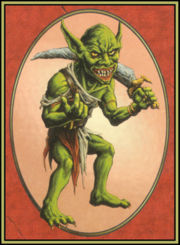Goblin
is a general term that can apply either to the ugliest members of the
fae, or to certain sub-races. Those fae numbered among the goblin
subraces, include the Scottish Trows, English Spriggans, Welsh Knockers,
Cornish Knockers, German Kobolds and Wichtlein, the Irish Phooka and
even Shakespeare's infamous Puck .
Aka : Hobgobs, Gobelins, Hob-thrush, Blobins, Bogles, Bogies, Brags, Boggarts, …
However, according to "The Concise Oxford Dictionary of Current English" the name is probably derived from the Anglo-Norman language gobelin (medieval Latin gobelinus), which is probably a diminutive of Gobel, a name related to the word kobold. Goblin is also related to the French lutin.
Goblin women steal human babies, replacing them with ugly goblin babies (changelings).Goblin changelings are sometimes known as "oafs" or "crimbils".
Mine goblins make knocking noises by stricking pickaxes and hammers against the stones. Some miners take the resulting sounds as a sign of good luck, believing they indicate the presence of rich deposits of ore. Other believe that they (Kobolds and Wichtlein) just imitate the miners to fool them. As a death companion he is sometimes accused to cause underground fires or warn for the coming deaths. To avoid the Knockers' wrath, a pastie (traditional miner meal) should be left for them.
Other traditions:
One fabled origin for Goblins is in France, in a cleft of the Pyrenees, from which they spread rapidly throughout Europe. They hitched a ride with Viking ships to get to Britain. Bryn y Ellyllon 'The Hill of the Goblins' is a place in Somerset. The Gap of Goeblin is a hole and underground tunnel in France.
Read more: http://www.monstropedia.org/index.php?title=Goblin#ixzz2DVjY0k7G
Aka : Hobgobs, Gobelins, Hob-thrush, Blobins, Bogles, Bogies, Brags, Boggarts, …
Etymology
According to some traditions, goblin comes from Gob or Ghob, the king of the gnomes, whose inferiors were called Ghob-lings.However, according to "The Concise Oxford Dictionary of Current English" the name is probably derived from the Anglo-Norman language gobelin (medieval Latin gobelinus), which is probably a diminutive of Gobel, a name related to the word kobold. Goblin is also related to the French lutin.
Description/Morphology
They grow up to 30 cm and are covered with a thick coat of black/grey hair. The Goblin is usually found wearing very dark colored cloths and a tall cap similar to that of the Gnome. They can appear as animals. They have a somewhat bestial or grotesque appearance: their brow is fully covered with thick hair and their mouth is filled with yellowed, crooked teeth. Female goblins are referred to as "hags" or "crones". It is said that they mimic human actions in their sardonic way, twisting human rituals and culture to show the worst aspects. In recent depictions Goblins have been portrayed as green in color. There is no tradition of this practice.Family
Goblins are of the Unseelie Court, and are at war with fairies. In some circles, Goblins are considered to be the cousins of gnomes, except that gnomes are stupid and no one in their right mind would confuse the two.Element
Earth, associated with Death. Goblins are also associated with fire, or have the ability to create said element.Powers/Weaknesses
- They can appear as animals.
- They are sometimes said to be mostly invisible to human eye.
- They can weave nightmares out of gossamer and insert them into the ear of a sleeping human.
Behavior
Tricks : Goblins are pranksters, and are known for rearranging items in the house, tangling horses, banging pots and pans, removing the clothes from sleeping humans, knocking on doors and walls and even digging up the graves to scatter the bones around. Goblins like to borrow horses and ride them all night. If a horse is tired in the morning, it is said a goblin rode it. If a horse is panicking, the goblin is trying to mount it.Goblin women steal human babies, replacing them with ugly goblin babies (changelings).Goblin changelings are sometimes known as "oafs" or "crimbils".
Mine goblins make knocking noises by stricking pickaxes and hammers against the stones. Some miners take the resulting sounds as a sign of good luck, believing they indicate the presence of rich deposits of ore. Other believe that they (Kobolds and Wichtlein) just imitate the miners to fool them. As a death companion he is sometimes accused to cause underground fires or warn for the coming deaths. To avoid the Knockers' wrath, a pastie (traditional miner meal) should be left for them.
Other traditions:
- A goblin smile curdles blood.
- A goblin laugh sours milk and causes fruit to fall from trees.
Friends/Foes
Often portrayed as the vilains and troublemakers of faerie, Goblins are not truly completely evil. Though they seem to have no moral code of their own, they are happy to enforce the one of their human hosts. The miserly and lazy are apt to feel their pinch or find their rooms and possessions in disarray.Places
The English Hobgoblin loves to live in homes where he makes much trouble for the people who live there. Some other reside in mines where they search for treasure/trouble. Still others of the family prefer grottos, often residing in the same one for their entire life.One fabled origin for Goblins is in France, in a cleft of the Pyrenees, from which they spread rapidly throughout Europe. They hitched a ride with Viking ships to get to Britain. Bryn y Ellyllon 'The Hill of the Goblins' is a place in Somerset. The Gap of Goeblin is a hole and underground tunnel in France.
Read more: http://www.monstropedia.org/index.php?title=Goblin#ixzz2DVjY0k7G

Δεν υπάρχουν σχόλια:
Δημοσίευση σχολίου